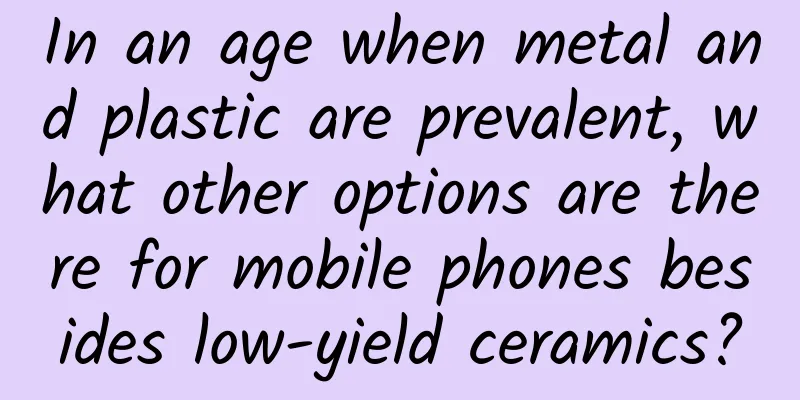In an age when metal and plastic are prevalent, what other options are there for mobile phones besides low-yield ceramics?

|
There are so many mobile phone launch conferences throughout the year that you can’t even count them with your fingers and toes. However, unlike the great leap forward in the number of press conferences, the body materials mentioned by mobile phone manufacturers at the press conferences are still mainly metal. Some all-metal one-piece bodies have also derived the concept of "metal ratio", just like the popular "screen ratio" two years ago; another major category is glass and glass-like materials, ranging from sapphire to zirconium, and the shape has also increased from 2.25D bending to 3D. Of course, more often than not, the metal and glass we see at press conferences will be mentioned, and descriptions such as "hyper-curved glass + metal middle frame" are not uncommon. In addition, there is another material that has become increasingly prominent at the press conference, giving people an extremely high-end feeling. This material is ceramic, which takes into account both texture and feel. Oh wait, there seems to be a most common material that has not been mentioned, that is plastic. Of course, this is not difficult to understand. There are so many mobile phones released in a year, and the mobile phones that can enjoy the treatment of press conferences are naturally mid-to-high-end products or key products, while low-end mobile phones with plastic bodies are just released casually. What are the advantages and disadvantages of the three common materials? Metal Just like PC, ABS, PP, PE, PVC, and PS are all collectively referred to as plastics, the metals used in mobile phones actually have different classifications, but the metal material in mobile phones is mainly aluminum alloy, that is, aluminum metal is mixed with a small amount of magnesium or other metal materials to enhance its strength. Depending on the added metal, there are magnesium aluminum alloys and titanium aluminum alloys. Some high-end mobile phones may also use gold plating. For example, the back cover of Xperia XZ is mostly made of ALKALEIDO magnesium-aluminum-lithium alloy, which has good rigidity and thermal conductivity, excellent electromagnetic shielding, and is also thin and light. Due to Sony's processing technology, this metal material gives XZ a glass-like look, clear and shining. The HTC One series, iPhone 5 and later models, which also use aluminum alloy, are among the best mobile phones using aluminum alloy. The addition of aluminum alloy (as well as the processing technology of these brands) also makes the look, texture and feel of these mobile phones reach a first-class level. However, when using thin aluminum alloy, these mobile phones also encounter some awkward situations. One of them is the iPhone 6 "bending problem", the main reason for which is that the 6000 series aluminum alloy used in the iPhone 6 is not strong enough. The iPhone 6s has improved after using the 7000 series aluminum alloy. In this regard, the stainless steel middle frame used in iPhone 4/4s and Xiaomi Mi 4 performs much better. Of course, Xiaomi promotes this material as "Austenitic 304". However, in addition to being not wear-resistant enough and being easily oxidized, metal still has two problems that may be difficult to avoid. First, the color of the metal body. Generally speaking, after the metal body gradually became popular, most of the mobile phones on the market are nothing more than "gray (black) white (silver) gold powder" colors. So what is the reason for this phenomenon? If we want to explore the reason, we have to start with the anodizing process. According to relevant chemical professionals:
The reason for this is that dark anodized aluminum is more difficult to color than light colors. If you insist on a rich, colorful design that doesn’t fade easily, more complicated processes are needed, which in turn increases the cost of the phone and the difficulty of mass production. Furthermore, it is difficult to truly achieve the integrity of a metal body phone. The upper and lower antenna strips of the iPhone, the plastic sheet on the back cover of the Sony Xperia XZ... these designs have caused consumers to complain. The lack of perfection in these designs comes from the characteristics of metal, which is the electromagnetic shielding mentioned above. After all, a mobile phone is a device for communication, and all designs require the signal exchange of the mobile phone to compromise. Under current conditions, there is no communication technology that can penetrate electromagnetic shielding. Therefore, mobile phones with metal back covers have to add antenna strips for this purpose. Perhaps all mobile phone manufacturers can do is to reduce the proportion of plastic antennas on the back cover while keeping the signal as stable as possible. For example, the "micro-slit antenna" of OPPO R9s makes the metal proportion of the back cover of the mobile phone exceed 98%. Unfortunately, however, this still doesn't seem to be extreme enough for obsessive-compulsive users who pursue perfect integration. Glass In addition to metal, glass is also widely used in mobile phones, such as the classic iPhone 4/4s, Xperia Z series or Samsung S6/S7. Unlike metal, which requires processing technology to reflect its texture, the crystal clearness of glass itself makes the texture of the phone not too bad. It is also because of this transparency that the coloring of the phone is not as difficult as the anodizing of metal. Not to mention, glass does not have the electromagnetic shielding properties of metal, and the back cover of the phone does not need to be specially designed with the annoying plastic antenna strip. The integrity of the phone design can be better satisfied. Because the hardness of glass is large enough, in daily use, glass-body phones do not have to worry too much about scratches. However, glass also has its disadvantages. Since its thermal conductivity is not as good as metal, the cooling system of the mobile phone must be carefully designed. A more serious disadvantage is that glass, or amorphous materials such as silica, lacks stability in its molecular structure. In layman's terms, it is fragile. In order to improve this shortcoming, different manufacturers have tried different methods. For example, Sony's method on Xperia is to make the middle frame slightly protruding, higher than the surface of the glass back cover. This can indeed reduce the chance of the back cover breaking due to the phone falling. However, the consequence of this design is that it feels scratchy. Also because of the difficulty in processing glass, under the current circumstances, most mobile phones made of glass adopt the design of "glass back cover + metal middle frame", which is still far from a truly full-glass body. ceramics It should be pointed out that the "ceramics" used on smartphones are different from the most common "ceramics" in daily life. Ordinary ceramics are essentially the same as the glass mentioned above, both are amorphous materials. If ordinary ceramics are used in mobile phones, they are not only thick and heavy, but also too brittle and easy to break. The ceramic material used in mobile phones, such as yttrium-stabilized zirconia, is actually a composite material. As a result, this material has both the luster of metal and good ductility, which makes it less likely to cause problems such as the glass body bursting during the later finishing process; it also has the advantages of glass, which is clear and hard, so there is no need to worry too much about scratches in daily use of mobile phones. In general, the ceramic material on the mobile phone combines the characteristics of metal and glass, and is a more ideal material for high-end mobile phones. However, there is no perfect material, and the same is true for ceramics. As mentioned above, when ceramics acquire the characteristics of metals and glass, they also inherit their shortcomings. For example, although the ductility has improved, in fact, ceramics are also easy to break due to their high hardness; although not as exaggerated as metal, ceramic materials still have a certain shielding effect on signals, so this also puts higher requirements on the antenna design of manufacturers. One of the biggest problems for ceramic materials to become truly popular in mobile phones is that it is difficult to reduce the cost. Take the ceramic shell of Xiaomi MIX as an example. According to Xiaomi, ceramics need to be fired at a temperature of more than 2000℃, and will shrink significantly before and after firing, which makes it difficult for manufacturers to control its shape, and the firing process will be wasted if there is any carelessness. Therefore, the yield rate of Xiaomi MIX is only 10%. Such a low yield is basically unimaginable for products that need to be mass-produced and put on the market on a large scale. Therefore, before this, this material was mostly used in the buttons of Vertu and other mobile phones. This year, the ceramic version of Xiaomi Mi 5, which uses a ceramic body, has been troubled by production capacity, and Xiaomi Mi MIX has directly launched the banner of "concept phone". If ceramic materials are to become truly popular, a breakthrough must be made in the issue of yield. What materials may mobile phones use in the future? In addition to the above three materials and plastic materials, there are many materials that have appeared in the mobile phone industry. Bamboo, black almond wood, rosewood, leather, cloth, and even denim have all appeared on mobile phones. But basically, mobile phones using these materials are in the form of customized or limited editions, and it is rare to see these materials on more common mass-market mobile phones. In the future, what other materials may appear on mobile phones on a large scale? Maybe carbon fiber is a good choice. Carbon fiber has the characteristics of general carbon materials such as lightness, high temperature resistance, wear resistance, electrical conductivity, thermal conductivity and corrosion resistance, etc., but unlike general carbon materials, carbon fiber has significant anisotropy, is soft, can be processed into various fabrics, and can show high strength along the fiber axis. Compared with metals and even composite materials such as ceramics, its strength is unmatched among existing structural materials. It is also because of these characteristics of carbon fiber that this material has been used in the aviation field since the 1950s. For the mobile phone industry, the potential of carbon fiber lies in the fact that it has both the strength of magnesium-aluminum alloy and the high plasticity of plastic. Although it looks a bit similar to plastic, its strength and thermal conductivity are much higher than ordinary plastic. Moreover, any traces of oily water pens on the surface of this material can be easily erased. In fact, this material has been in the mobile phone industry for quite some time, but why has it not been widely used until now? There is only one reason: the cost is too high. Therefore, carbon fiber is mainly used in Vertu or some expensive custom phones. Many mobile phone manufacturers are constantly trying new materials on their flagship products. In the future, there may even be mobile phones made of liquid metal or graphene. This behavior is certainly worthy of recognition. However, if we ignore the improvement of technology, it is somewhat putting the cart before the horse. Just like Lumia or iPhone 5c in the Nokia era, the design level of these plastic phones is still out of reach for most of the current thousand-yuan metal phones. After all, high-end is not about materials, but about craftsmanship. As a winner of Toutiao's Qingyun Plan and Baijiahao's Bai+ Plan, the 2019 Baidu Digital Author of the Year, the Baijiahao's Most Popular Author in the Technology Field, the 2019 Sogou Technology and Culture Author, and the 2021 Baijiahao Quarterly Influential Creator, he has won many awards, including the 2013 Sohu Best Industry Media Person, the 2015 China New Media Entrepreneurship Competition Beijing Third Place, the 2015 Guangmang Experience Award, the 2015 China New Media Entrepreneurship Competition Finals Third Place, and the 2018 Baidu Dynamic Annual Powerful Celebrity. |
<<: Domestic phones have no screens available, Samsung OLED will only be enough for Apple next year
>>: Is there hope? Rumor has it that AirPods wireless headphones will go on sale next week
Recommend
The new idol era: fan economy and social platforms reconstructed by live streaming
WeChat still throws out easter eggs from time to ...
The crux of virtual reality content: what is missing besides technology
Unlike the underlying hardware and software, ther...
4 strategic methods and ideas for product operation!
If we want to develop an operational strategy/pla...
Huawei is not satisfied with the Internet of Vehicles and has teamed up with Audi to develop autonomous driving
On October 11, Huawei and Audi jointly announced ...
User fission growth tips!
There is an old saying: Three incompetent general...
[Dry Goods] ASO optimization black technology: fast review, keyword coverage, Apple list update rules!
Quick review Let me tell you the specific operati...
When bees move to cities, can humans be good neighbors?
When it comes to bees, do you first think of beeh...
How to use Xiaohongshu to accurately attract traffic?
Traffic generation has always been the beginning....
How to make money with WeChat red envelopes (I’ll give you the specific method)
It is no longer a secret that making money with W...
What does the last column of the nutrition facts table mean?
Nowadays, many people are very familiar with chec...
The most "curly" ginkgo pest in nature: the super small leaf roller
Ginkgo is a "living fossil" left over f...
Product traffic methodology: How to find your precise users?
There are many people who have learned many metho...
iOS 18 new features exposed, finally here!
Generative AI technology is very popular this yea...
A feasible solution for adding fans in private domain!
More and more people realize that private domain ...
What kind of rain is considered heavy rain? Why are 50 and 100 mm important rainfall scale nodes?
Review expert: Ye Haiying, deputy director of the...









